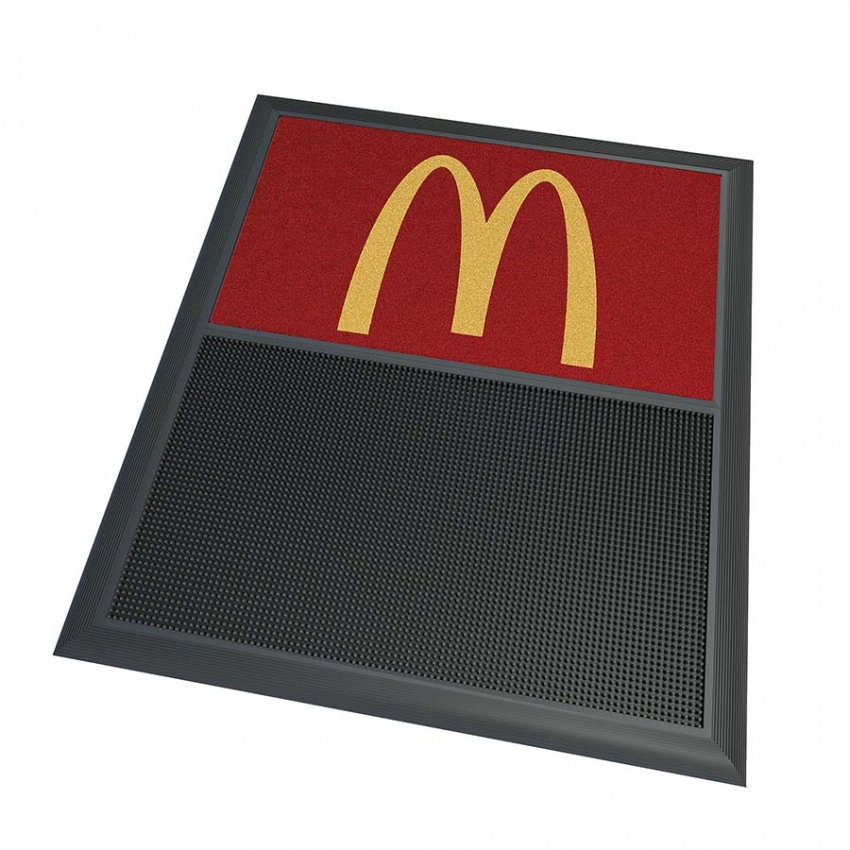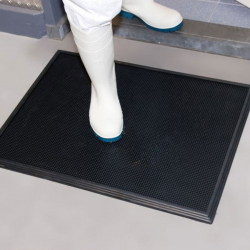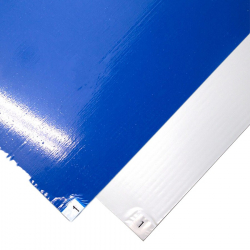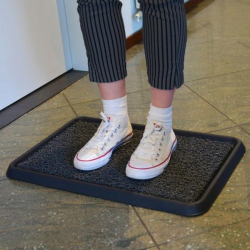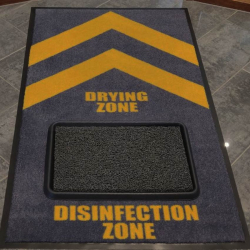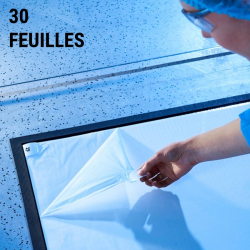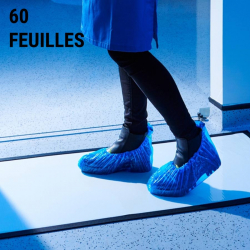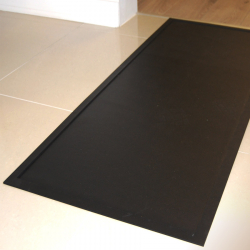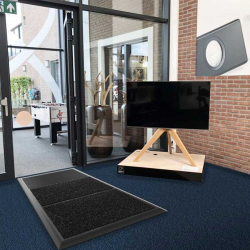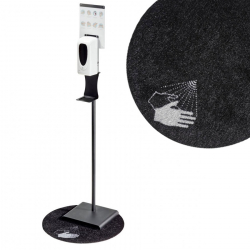Customizable modular disinfection mat
Disinfectant mat kit for shoe soles: a standard component of hygiene protocols.
Combines 3 features: disinfection - absorption - modularity in a single solution: Disinfecting entry mat. Cleans, disinfects and dries shoes. Assembled from a disinfectant mat holding up to 4 liters of diluted disinfectant solution and 2 absorbent mats for drying shoe soles.
The 2 drying zones can be customized with logos, drawings, images or to communicate hygiene protocols such as hand disinfection and social distancing. The drying zone can be made longer for optimum action.
Available in standard and custom sizes.
TAPIS 1: a tray for disinfecting soles, with flexible bristles that bend to immerse the soles in the disinfectant solution for washing and disinfecting shoes at building entrances.
TAPIS 2: mat to allow soles to dry and prevent slipping thanks to an assembly system.
TAPIS 3: The 3rd mat allows the soles to dry completely, preventing marks on floors.
Made of 100% resistant natural rubber; designed to withstand most chemicals and temperature variations.
RECOMMENDED APPLICATIONS :
Traditionally used in the food industry, this type of mat has become a common feature of general hygiene protocols and is recommended at the entrances to schools, hotels, gymnasiums, offices, pharmacies, healthcare facilities, hospitals etc. to prevent the spread of contamination from entering buildings.
Fast delivery (within 5 working days)*
Delivery times are ex works.
They are indicative and subject to product availability from our factories.
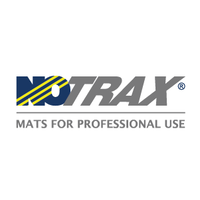
| 348 sani master |
Data sheet
| Format | Slabs |
| Location | Interior Outdoor under cover |
| Intensity of passage | Intense Very intense |
| Properties | Absorbent Customizable Scraping |
| Composition | Natural rubber |
| Thickness | 19 mm |
| Borders | Yes |
| Fire classification | Cfl-s1 |
| Absorption capacity | 4 L / m2 |
| Resistant to chemicals | Yes |
| Maintenance / Cleaning | Vacuum cleaner |
| Wear index | 3/3 (Excellent) |
- attractive design
- resistance to traffic
- excellent functionality
- Humid environment: you should opt for an absorbent or non-slip anti-fouling mat to prevent moisture from penetrating your premises.
- Dry environment: you should opt for a scraping mat that will catch all the debris and dust found under the soles of your customers' shoes.
- Up to 250 passages/day: standard traffic mats .
- Up to 500 passages/day: heavy traffic mats.
- Over 500 passages/day: very heavy traffic mats.
- Scraping mats : Scraper mats have dry, hard fibers for effective scraping of shoe soles. Used in dry, dusty environments.
- Absorbent mats: Absorbent mats absorb moisture brought in by passers-by. Depending on the mat, they can absorb 3 to 6 L of water per m2, and are known as water-barrier mats.
- Non-slip mats: Anti-slip mats also have a scraping function, preventing dirt from entering the premises. However, they have one more function than scraping mats: they have anti-slip properties. These mats are most often used outdoors.
- Public buildings
- Condominiums
- Offices
- Administrations
- Stores
- Schools
- etc ...
- Colors to suit all tastes
- Designs to enhance your entrance
- Sizes to fit your space.
- Inaugurations
- Special events
- Trade fairs
- Advertising purposes
- Promoting your services and business
- Standardizing franchises
- Make yourself visible to the outside world.
- to highlight your store
- standardize your entrance
- advertising at points of sale.
- Profile height: the higher the profile, the greater its dirt-holding capacity.
- Profile types: the thicker the profile cross-section, the more resistant the mat will be to rolling loads.
- Coatings: (reps, rubber or brush): The place of installation, the environment and the type of soiling determine the type of covering.
- Reps,
- Brush
- Gum
- Choice of height, etc.
- musculoskeletal disorders (MSD),
- electrical shocks ,
- ensure a clean and healthy environment in the food industry, by preventing the proliferation of bacteria for example.
- Anti-fatigue mats : can be used in manufacturing industries, packaging centers, retail outlets and catering establishments.
- Antistatic mats: used in industries (welding stations).
- Agri-food mats: used in industrial kitchens, restaurants/hotels, canteens, etc.
- Wet environment: in a wet environment, the mat must not be slippery, so it must have anti-slip properties and a perforated surface to allow drainage of liquids.
- Dry environment: in a dry environment, the mat must have a granular, ergonomic bubble, striated or diamond plate surface. However, depending on the environment in which the mat is used, it must meet specific hygiene standards (kitchens, pharmaceutical industries, food processing plants, etc.).
- Polyester grating: 65% resin for chemical and UV resistance, 35% fiberglass for high mechanical strength. Molded in panel form, it guarantees excellent resistance to varying degrees of corrosion and chemical aggression.
- Rubber gratings: All our rubber products comply with the Reach regulations adopted to better protect human health and the environment against the risks associated with chemical substances. They are water and UV resistant, anti-slip, anti-fatigue, environmentally friendly, biodegradable and recyclable.
- Hygienic grating: Made from moisture- and UV-resistant PVC, hygienic grating prevents the spread of bacteria and keeps wet environments clean while protecting users.
- Metal grating: commonly used for technical walkways and stair treads, but also in the building industry for facade elements, fencing and railing infill.
Anti-dirt-repellent mats are the first line of defense in keeping dirt and debris out of buildings. They improve air quality, reduce noise resonance, extend floor life and cut maintenance costs.
Dirt-repellent mats also facilitate access for people with reduced mobility, while ensuring the safety of all users (avoiding falls, slips, etc.). But they also contribute to the cleanliness and hygiene of your premises, while enhancing your image, since the entrance is the first impression your customers will have of your establishment.
To cut a long story short, a dirt-repellent mat must meet 3 main criteria:
When choosing an antisoiling mat, there are a few criteria to consider:
Your environment:
Type of traffic :
There are 3 ranges of dirt-repellent mats:
Professional dirt-repellent mats are used in all establishments with one or more entrances, such as :
We offer a wide choice of dirt-repellent mats:
Custom mats meet a number of objectives, not only for cleanliness but also for communication. They are innovative communication tools that will make you stand out from your competitors and standardize your franchises.
They can be used to welcome your customers in your image, give you visibility from the outside and attract passers-by who don't yet know you. They can also be used as a gift from you to your partners, or as a point-of-sale advertising tool.
You can use personalized mats for :
To choose a customized mat, you first need to know your needs:
Then choose where to place it: indoors or outdoors.
Customized mats help you stand out from your competitors, make your entrance look as good as your brand image, attract passers-by if the mat is outdoors, advertise in an innovative way.
We offer you a range of customized mats with different functionalities and a wide choice of colors.
We can offer you visuals, provided you give us your personalization requirements: logo, company name, details of services offered, etc., and we'll send you a mock-up.
Retains virtually all dirt thanks to an ingenious combination of technical entrance mats mounted on aluminum profiles and cleanliness coatings.
Ideal for the heaviest traffic, over 1,000 passages per day, and withstands caddies, carts, baby carriages and suitcase wheels.... Reduces the risk of slipping on wet floors and the cost of cleaning your entrance. Suitable for high-end building entrances that require a bright mat without loss of quality.
Aluminum mats are used when an entrance is used by more than 1,000 pedestrians or wheeled loads per day. When the reception area is divided into 3 zones (outside, inside entrance, inside building)
When choosing an aluminum mat, there are a few criteria to take into account:
(Reps ensures dirt pick-up and moisture absorption. Rubber and brushes only capture dirt).
We offer a wide choice of colors to match your interiors.
Several cladding styles to choose from:
Flexible, customizable combinations of different types of matting for complementary, consistent action whatever the configuration of your entrance.
Industrial mats meet the needs of ergonomic workstations and employee well-being.
They prevent:
There are many uses for industrial mats:
Safety criteria: The mat must cover the entire workstation, be firmly attached to the floor, not shift or slide, and have bevelled edges to prevent falls.
Thickness and flexibility criteria: Contrary to what you might think, you shouldn't choose a very thick or very soft mat. The mat should have a certain elasticity, but still allow a comfortable standing position, without the user feeling slumped.
Environmental criteria :
Environmental hazard criteria : To establish more precise characteristics for a mat (antistatic properties or fire resistance etc...) we need to take into account the hazards present in the environment where the mat will be installed.
Where hazardous liquids are present in the working environment, the anti-slip properties and chemical resistance of industrial mats should be taken into account. The presence of openings on mats to allow the evacuation of fluids is essential.
Traffic criteria: We need to take into account the traffic that takes place on the equipment: how many workers can walk on it? How often, etc., in order to choose the most suitable mat.
Prevent the many problems associated with poor workstation ergonomics: RSI, static shock, bacterial proliferation, etc.
We offer a wide choice of industrial mats: on rolls, in standard sizes, made-to-measure or modular mats to suit all types of workstations.
Grating is a square slab of metal, polyester, rubber or PVC, made up of several parallel slats. The slats come in a variety of sizes, species and colors, and are grooved to prevent water from stagnating and the floor from becoming slippery.
Polyester gratings: Food industry - Paper and cellulose industry - Pharmaceutical industry - Plastics industry - Fiber and textile industry - Automotive and aircraft construction - Offshore installation - Sewage treatment plant - Navy and shipbuilding - Transport - Pickling and galvanizing plant.
Rubber gratings: Can be used in a wide range of applications: building entrances, walkways, stairs, access paths, production lines, ski resorts, etc.
Hygienic gratings: swimming pools - changing rooms - saunas - hotels - kitchens - steam rooms, etc.
Metal gratings: Thermal, hydroelectric, nuclear and solar power plants - Chemical and oil industries - Automotive and steel industries - Shipbuilding - Cement works - Metal processing and construction - Railways and transport

